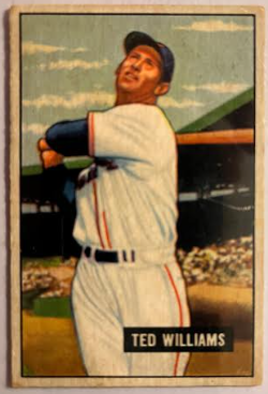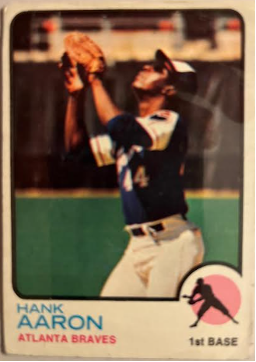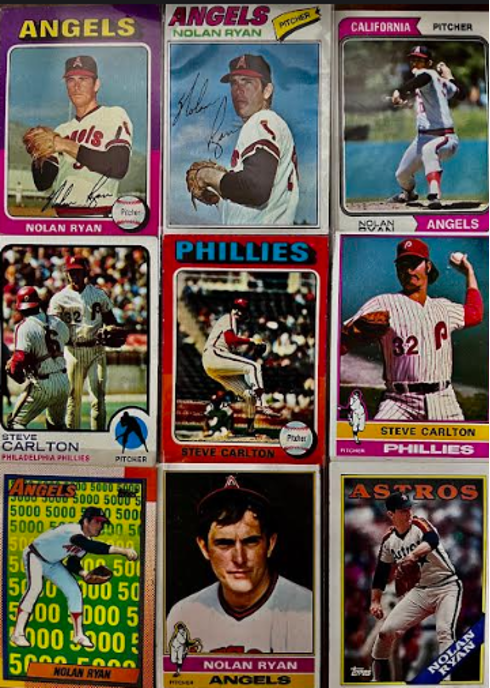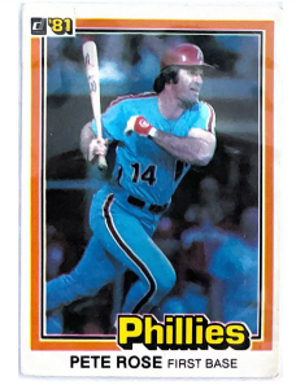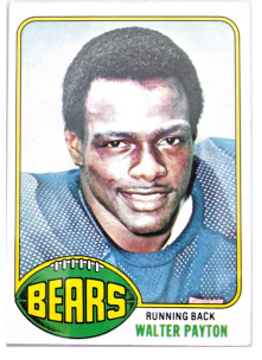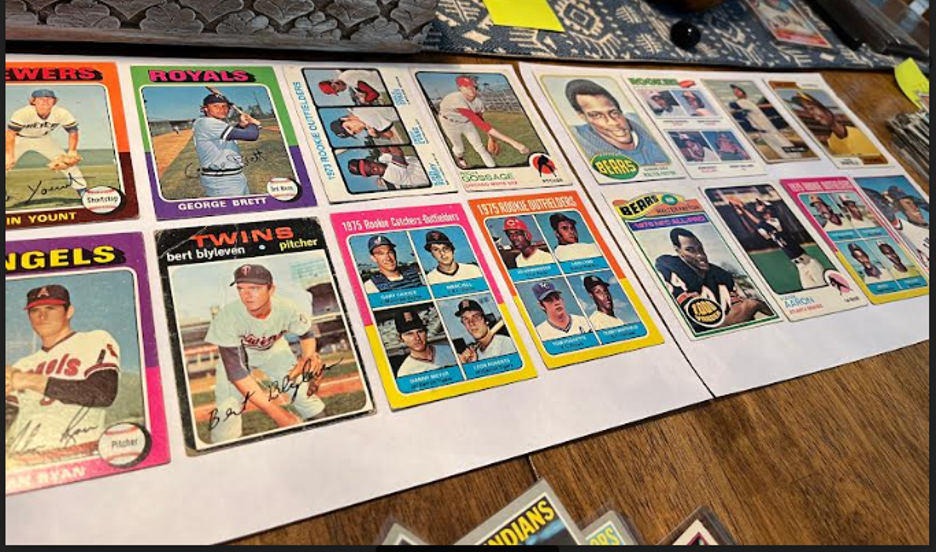
Prompt Images
Last month I finally pulled out that dusty box in the garage loft.
Devin’s Baseball Cards
I’d run across it often, another tedious chore staring at me. Heavier than I remembered, I set it down on the living room floor and pulled off the top. Within minutes, I was eight again.
Saturdays at the store, mom would slip me a dollar. Clear, twenty-five cent plastic packs, twelve cards each, the top and bottom cards exposed. After great deliberation, I would select four packs, then spend the afternoon introducing the new cards to the rest of the team. During the school week, I’d haul my case of cards to recess. A convention of little general managers assembled to conduct negotiations and make deals.
Juice boxes and Snickers bars were our whiskey and cigars.
I emptied the box and made piles by year and sport, relieved I had foresight enough to put some in plastic sleeves. It took three nights to organize, a task made longer as I studied the backs, checking out statistics, admiring the details of each card.
My childhood deal making had netted me over 3,000 cards.
After checking values online, I thought I might actually have something. Values start with mint condition. The top three card grades range from approaching perfect (MT-8), to near perfect (MT-9), to perfect (MT-10). Serious collectors only pay top dollar for cards that have certified grades. A perfect MT-10 for a vintage card is rare, and for very select cards, can fetch a fortune.
I carefully segregated my very best cards…contemplating my next deal.
Ted Williams – 1951 Bowmann
I’d just started collecting when my uncle handed me a rubber-banded stack of old cards from a desk drawer. Small and grainy with faces unfamiliar, I preferred my slick, colorful cards with players I knew from TV. It wasn’t until I had a deeper appreciation for the game that I realized what he’d given me. Among these cardboard ghosts was a ‘51 Ted Williams. Last guy to hit .400 (impossible today), he enlisted after Pearl Harbor and flew missions in both World War II and Korea. Given his years away from the game in combat, his career statistics are spectacular. He even homered in his final at-bat.
I never saw Williams play aside from old film clips. His career spent on marginal Boston teams with fickle fans, he was famously intense. Later interviews painted him as perpetually angry, combative and thin-skinned. Like so many from our greatest generation, he seemed like a quiet, old-school, hard ass dad. I was in awe of him.
That feeling of awe returned as I came across this card. An MT-10 ‘51 Ted Williams would be worth $31,500. Given the worn condition of my card, it’s likely worth only $500-$750.
Hank Aaron – 1973 Topps
That first year I collected, this was one of the most coveted cards. Hank Aaron was chasing an unbreakable record: Babe Ruth’s 714 career home runs. By late summer the news would replay every homer from the night before as Aaron closed in. The ‘74 season began with Aaron tying it on his very first plate appearance. Fate would let him break the record on a Monday night when the whole country could watch the Braves play at home against the Dodgers.
I remember somersaulting on my bed when it finally happened. I’d never seen a game stop for what seemed like forever. So much pageantry and celebration for this humble hero.
I was too young to understand racism. For me, this event would provide a crash course. Why would anyone taunt and threaten him and his family (even some hometown Braves fans) for breaking a white man’s record? I soon learned that there had been separate Negro Leagues (where Aaron and a few others that were still playing in ‘74 had started), and that even after the leagues integrated, black professional black athletes routinely suffered every imaginable indignity while traveling across this country. Sadly, some still do.
Thirty-three years later, Aaron publicly accepted his record being broken by a fraudulent, reported steroid user, and with notable grace.
This card reminds me of that joyful night in ‘74, and a lot of other stuff. A mint-grade ‘73 Aaron might get $13,000. Mine is in only fair condition at best.
Nolan Ryan / Steve Carlton – Topps (various) 1973-1986
From my very first encounter with baseball, the local Philadelphia Phillies were an obsession. My pitching idol was their ace, Steve Carlton. “Lefty” had a nasty slider that embarrassed hitters. The ball started high and left, then slashed rightward as it dropped across the plate. While technically a strike (while often landing in the dirt), nobody hit it. Carlton was traded to the Phils at the exact moment I discovered baseball. Historically woeful Philadelphia would gradually build a team around him, and their fortunes would improve.
That same year over in the other (American) league, Nolan Ryan reigned supreme. A refugee from the ‘69 Amazin’ Mets, he was a fire-hurling force of nature. His unique brand of heat inspired the invention of the speed gun. I wondered how any batter summoned the courage to stand in close on a 108.1 mph pitch (nobody comes close, even today). The California Angels were never on TV and never in contention, but Ryan always led the league in just about everything.
A decade later these two would stand side by side atop the pitching universe taking turns breaking each other’s all-time career strikeouts record with every outing. Carlton’s Hall of Fame career would eventually run out of gas. Distrustful and paranoid of sports writers, he’s now an outspoken lunatic conspiracy theorist in Colorado. Nolan Ryan kept throwing fireballs deep into middle age, and today holds a miles-long list of pitching records so ridiculous that most can’t ever be broken. He runs a small, family ranch in Texas.
Carlton’s cards, even in mint condition, might get $500-750. Depending on the year, Ryan’s can top out around $50,000 in mint condition. Mine are in surprisingly good shape.I might sell them as a set and aim for maybe $1,500-2,000.
Pete Rose -1981 Topps
The ‘70s saw my Phillies creep closer to the World Series. The missing piece was finally added in ‘79. Pete Rose became a Philly, and the highest paid professional athlete at that moment. Nicknamed Charlie Hustle, Pete just out hustled everybody else with infectious enthusiasm. After a blessed ‘80 championship (their first ever), the only thing that could possibly stop them that year was an impending June labor strike.
But before the strike deadline, one game remained. Phillies vs Astros, a night game at the Vet. Pete was chasing the NL hits record, just one hit shy. Carlton was pitching against Ryan, the Astros new ace.
Great Googly Moogly!
I was 15 years old. Somebody I knew had a car. A bunch of us piled into it and spent everything we had for third baseline seats near the foul pole.
Pete led off the 1st. CRACK! A stinging liner up the middle. The game stopped as they removed first base, presumably for Cooperstown. Stan Musial, the NL hits record holder, waved congratulations from the press box while we gobbled ballpark hot dogs.
But the Phils couldn’t score, and both teams settled into an intense pitcher’s duel. By the 7th, the Astros had scratched out four runs, driving Carlton out. Ryan just kept throwing heat.
And then unexpectedly in the bottom of the 8th, Ryan got pulled. The Phils rallied, and with a late three-run homer, the stadium erupted. Then Tug McGraw, fresh off his World Series spastic mound celebration, did another one just for us.
Freakin’ surreal. And we’re just getting to the best part…
After the game, we decided Pete Rose needed to be congratulated personally. One of us knew where the players parked their cars so we barreled down the stadium ramps and found that lot, which to our surprise was unattended. We marauded around like hooligans in the shadows for maybe 30 minutes. Finally a guy with a gym bag and the hairiest forearms I’d ever seen emerged through a door, trying to get to his car.
Earlier that afternoon I was in Harrisburg with friends, dreading another boring summer day. Eight hours later, on a truly historic night in baseball, I was hugging Pete Rose.
The strike lasted just two months. Pete went on to not only break that NL hits record, but would eventually put the all-time league hits record far out of everyone’s reach. And he would also be banned for life from baseball for gambling on games. Today he can be found just about everywhere hawking overpriced autographs.
I have most of the Pete Rose cards from the 1970s, all in good shape. The whole set might get $500. My ‘81 Rose is probably the least valuable. It just brings back that unforgettable memory.
Walter Payton – 1976 Topps
As a kid, I remember playing a game called “kill the pill,” where someone (courageously) grabs the football and runs wildly in circles while everyone tries to tackle them.
Kill the pill is exactly how to describe most of Walter Payton’s 12-year unforgettable professional football career. Except in his case, he sometimes managed to single-handedly prevail over 11 would-be tacklers.
I was 10 when I first saw him on TV, the first person I ever saw as an actual living superhero. And over many seasons of perpetual futility, while churning up thousands of yards and absorbing insane punishment carrying the Chicago Bears on his back, I grew to love Walter Payton like no other sports figure. In ‘85, Payton led those pitiful Bears to a Super Bowl victory, a team remembered as perhaps the greatest ever.
Walter Payton died young. And in death, his legend grew even larger. So large that the NFL created a humanitarian award every year in his name. Humble Southern roots, Christian family image, tireless charitable work (particularly after retirement), and countless testimonials from people he touched in a positive way. All these factors made him seem immortal to me.
In 2011, sportswriter Jeff Pearlman was releasing an unauthorized Payton biography. Pearlman wrote and continues to write definitive portraits of controversial sports legends with painstaking research. Up to that time, everything ever written about Walter Payton had been cakey, hero-worship pieces. I pre-ordered this book, eager to have my view of him more deeply reinforced.
The book arrived right before a business trip. Outside of working, I never put it down. On that last night in the hotel bar, I finished the last 120 pages (along with several drinks). Walter had the rare gift of knowing just what to say to people to inspire them, and he inspired countless people. But then there was the sham marriage, chronic womanizing, a borderline crazy juvenile streak, unacknowledged illegitimate children… disturbing stuff about the only person on Earth I still considered my hero.
But as it turned out, Pearlman loved Walter, too. He even said so at the book’s end. Despite Payton’s abundant flaws and failings, the biographer had fallen hard for him just as I had.
When I finished it, I did something I hadn’t done in many years. I cried (the drinks didn’t help). And then I pulled out my laptop and googled the author. Pearlman had a website with a place to send comments directly. I typed. I swallowed hard and thanked him for writing it. But I challenged his love with a question.
Would you have written it if Walter had lived?
I awoke to an unexpected, lengthy reply. He confessed that after weeks of vilification by the Chicago media, not a single person had ever asked him that. And after many rationalizations, he had no clear answer. Ultimately, he closed with this cryptic thought.
It would have changed much.
There are only ten MT-10 grade Walter Payton rookie cards in circulation. The last one auctioned for $81,000. Mine looks perfect, but as we know, looks can be deceiving. I’m getting this one graded. But whatever the grade, I’ve already decided…
I’m keeping it.

